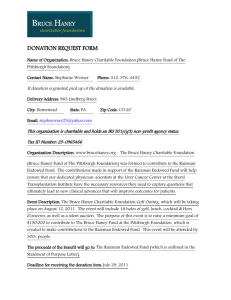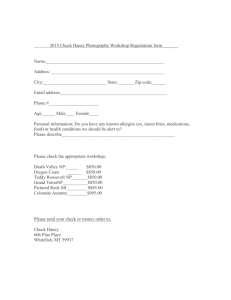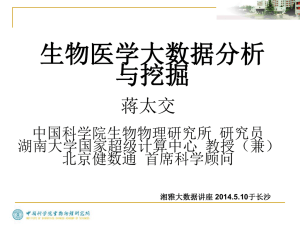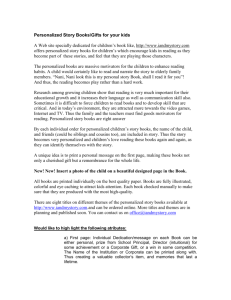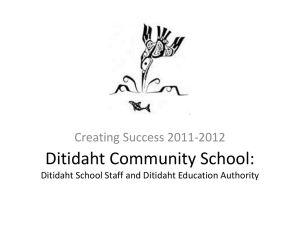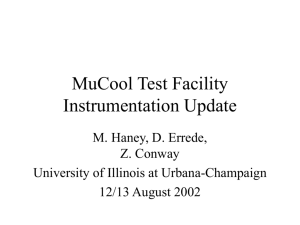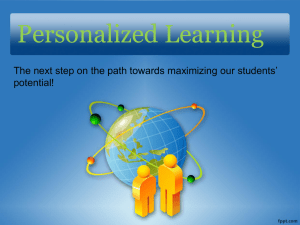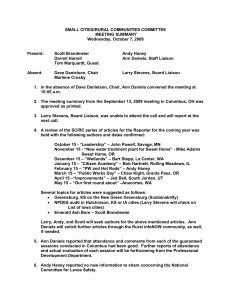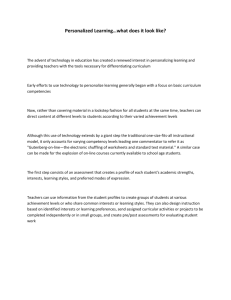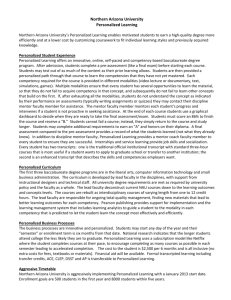Two Schools: Two Approaches to Personalized Learning
advertisement
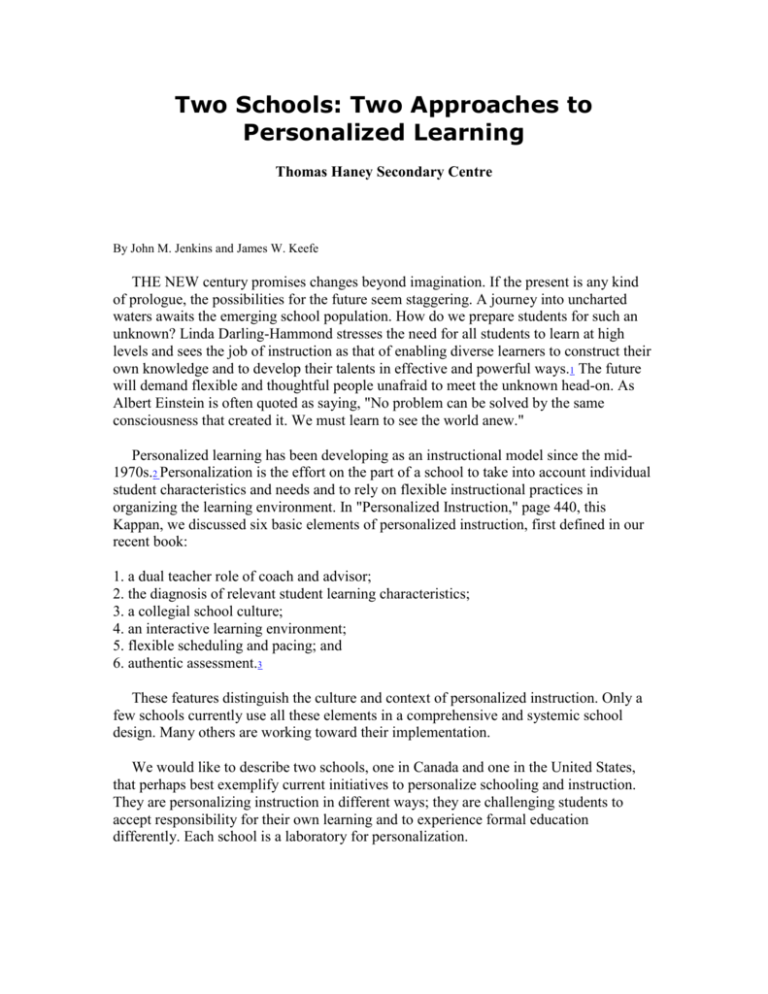
Two Schools: Two Approaches to Personalized Learning Thomas Haney Secondary Centre By John M. Jenkins and James W. Keefe THE NEW century promises changes beyond imagination. If the present is any kind of prologue, the possibilities for the future seem staggering. A journey into uncharted waters awaits the emerging school population. How do we prepare students for such an unknown? Linda Darling-Hammond stresses the need for all students to learn at high levels and sees the job of instruction as that of enabling diverse learners to construct their own knowledge and to develop their talents in effective and powerful ways.1 The future will demand flexible and thoughtful people unafraid to meet the unknown head-on. As Albert Einstein is often quoted as saying, "No problem can be solved by the same consciousness that created it. We must learn to see the world anew." Personalized learning has been developing as an instructional model since the mid1970s.2 Personalization is the effort on the part of a school to take into account individual student characteristics and needs and to rely on flexible instructional practices in organizing the learning environment. In "Personalized Instruction," page 440, this Kappan, we discussed six basic elements of personalized instruction, first defined in our recent book: 1. a dual teacher role of coach and advisor; 2. the diagnosis of relevant student learning characteristics; 3. a collegial school culture; 4. an interactive learning environment; 5. flexible scheduling and pacing; and 6. authentic assessment.3 These features distinguish the culture and context of personalized instruction. Only a few schools currently use all these elements in a comprehensive and systemic school design. Many others are working toward their implementation. We would like to describe two schools, one in Canada and one in the United States, that perhaps best exemplify current initiatives to personalize schooling and instruction. They are personalizing instruction in different ways; they are challenging students to accept responsibility for their own learning and to experience formal education differently. Each school is a laboratory for personalization. Thomas Haney Secondary Centre Background--Thomas Haney, located in Maple Ridge, British Columbia, opened in the fall of 1992, spurred by the leadership of the district superintendent, Denis Theirren, and his staff. Formal planning involved members of the district staff, potential administrators and faculty members for the school, and consultants from the Learning Environments Consortium International (LEC), a self-help cooperative of schools and districts in the western U.S. and Canada. Plans for the facilities were drawn from specifications that called for independent activities, collaboration, and large-group meetings as needed. The facilities at Bishop Carroll High School in Calgary, Alberta, served as a point of departure for this school for a new century. The building plans included open spaces, seminar rooms, regular classrooms, and specialized spaces for the arts, physical education, technical education, and the sciences. The goals for Thomas Haney were taken partially from the Year 2000 Report of the British Columbia Ministry of Education and partially from goals presented by a local design team. The first three goals were adopted from the ministry report: 1. Learning requires the active participation of the learners. 2. Students learn in a variety of ways and at different rates. 3. Learning is an individual and a social process. The final four goals were the work of the local design team: 4. That students learn is more important than when they learn. 5. All students can be successful learners. 6. Students learn best in a safe and orderly environment. 7. Learning is a lifelong process. The original plan was to develop a facility and an educational program for students assigned to a new attendance area, not a magnet school for students throughout the district. As the school developed, however, students from other areas of the district were permitted to attend, pending available space. The Haney Centre incorporates under one roof secondary education (grades 8-12), junior college (grades 13 and 14), and continuing education programs. A fundamental premise of the school is that, if students are going to learn to be independent, they should experience independent learning in spaces designed to support that kind of learning. Similarly, if students are to learn to work together in teams, they should experience learning in spaces designed to support collaboration. Thus traditional classrooms have been replaced, for the most part, by spaces designed for personalization. The building features a "Great Hall," a large open area where students obtain study guides and work at their own pace, either on their own, with another student, or with a small group of students. In the Great Hall, students work on mathematics, English, and social studies. They work on second languages in the school media center, near other spaces where "classes" meet periodically. Still other spaces are more specialized for individualized science, technology, art, music, drama, physical education, and business education. Implementing personalized instruction. Thomas Haney puts into practice all six elements of personalized instruction mentioned above. Dual teacher role as coach and advisor. Multi-age groups of 18 students meet with their advisors (teachers and administrators) 10 times each week. On Monday and Thursday, meetings are scheduled for one hour; on Tuesday, Wednesday, and Friday, for 15 minutes. The Monday meeting allows teacher-advisors to work with advisees to set goals for the week and to arrange their schedules accordingly. Thursdays are used to check weekly academic progress. As students advance at their own rates through a continuous-progress program of curriculum and instruction, advisors help keep them on track and intervene when appropriate. They also keep parents informed, in many cases on a monthly basis, even though district reports are issued only three times per year. All fulltime professional staff members serve as advisors. The advisor is the one adult in the school who has close, personal knowledge of all facets of a student's academic life and some facets of his or her personal life. The principal, Ian Strachan, states, "Any school in the 21st century that does not include an advisement system in its growth plans is doing a disservice to students." Teachers at Haney Centre also serve as learning coaches and facilitators to students engaged in their subject-area specialties. The school is organized so that eighth-graders follow a relatively traditional timetable (schedule) in structured classes while they are being introduced to self-paced learning guides and to learning at their own best rates for success. From grade 9 onward, students create their own timetables in conjunction with their teacher-advisors and with recommendations from their subject-area "markers" -- one teacher in each of the four subject areas assigned to meet with a student to give academic advice and feedback. Generally, students work on four learning sequences/courses at a time. Teacher-coaches monitor student work, provide coaching as needed, offer seminars for more complex content or for follow-up, initiate large-group presentations as appropriate, and assess student achievement. Diagnosis of student characteristics. Each student develops a personalized educational plan with the help of his or her advisor. Students are administered the Learning Style Profile (LSP), and the results of this instrument are used to help them choose activities from learning guides and to select appropriate learning environments. The teacheradvisor uses information about past student achievement, data from the LSP, and developmental information to create a personalized plan for each advisee. The plans are subject to modification based on the student's prog-ress, interests, and needs. Periodically, teacher-advisors provide direct instruction in study skills and time management. A student plan book is given to each advisee so that daily plans can be constructed. Advisees keep the plan books with them at all times and use them in conferences with their advisors to compare the amount of time spent in various areas of the curriculum with academic progress in each of these areas. A culture of collegiality. Teachers work in departmental teams. Common planning areas allow teachers to meet both in and across departments. Each teacher's workstation is equipped with a computer that links the teacher to databases detailing student progress and advisee background information. Students often work in pairs or learning teams as they complete activities from the many learning guides developed by teachers. It is not unusual to see students working together toward the solution of their common problems or students helping other students understand difficult material. When asked about the difference between Thomas Haney and her previous school, one student remarked, "It is more difficult here. I must do the work and do it well before I receive credit. I can also get help from my fellow students. We aren't competing with each other." An interactive and thoughtful learning environment. The curriculum at Haney is delivered using a series of learning guides for each course. The learning guides are written by teachers and address major course objectives. Varying activities are offered so that students can meet the objectives in accordance with their learning styles, knowledge and skills, and developmental needs. Each student is assigned a teacher marker in each of the four subjects he or she takes per semester. The teacher markers meet with students on a one-to-one basis as needed and review test results to give feedback. As students work to complete learning activities, they interact with their teacher markers and other teachers of the same subject. The open facilities of the Great Room, the media center, and other spaces enable teachers to move about the areas, observing students at work and intervening when appropriate. Course content is rigorous and focused on the standards mandated by the British Columbia Ministry of Education. In English and literature, students undertake many critical analyses. In the 12th-grade literature course, for example, students study 56 different works -- plays, novels, and poems -- from writers such as Chaucer, Shakespeare, Milton, Swift, Austen, and Dickens. Creative independent or group projects are built into the learning guides. Students are also encouraged to negotiate with subject teachers for projects based on individual interests. A typical project contracted by a student in 11th-grade English involved the construction of a portfolio of original poetry that later served as the focus of a one-person show for an audience of 200 students. Another project occupied a student in reading a series of historical novels and then writing an op-ed piece for the school newspaper. Learning guides are viewed as road maps that direct students to textbooks, outside readings, interactive software, hands-on materials, experiments, and community-based resources. Students are expected to accept a healthy degree of responsibility for their own learning, with teachers accessible to give help when needed. Flexible scheduling and pacing. Thomas Haney offers a student-driven schedule focused on continuous academic progress. With the help of their advisors, students build their schedules on a weekly basis. Changes can also be made throughout the week as needed. The advisor and the student are empowered to make decisions as to location and the amount of time a student may spend working on a particular course, unit, or learning activity. Computer networking allows subject teachers to report student progress back to the advisors. Subsequent placement and scheduling decisions are made in light of student progress. Teachers and teaching teams schedule group activities as needed. Some courses are scheduled two or three times a week because the nature of the program requires that students meet in groups. Other groups grow out of the learning guides and are scheduled on an ad hoc basis. Seminars in social studies and literature are offered, for example, when sufficient numbers of students are ready to engage in discourse. Essentially, students are able to spend as much or as little time working in specific areas as they need. If a student wishes to devote extended time to working on a project, he or she has only to check with the advisor and the subject teacher or teachers. It is not unusual for some students to work three or four days on one project exclusively. Authentic assessment. Students take tests when they are ready and not in accordance with a teacher-developed schedule. In this kind of setting, student comprehension takes precedence over simply accumulating grades for the report card. Teachers review test results and meet with students on a one-to-one basis to give feedback. Students redo any unsatisfactory work until all errors are corrected. Thus students are only in competition with themselves, and the normal curve is replaced by the school standards. Other forms of assessment include presentations to faculty members and other students, project exhibitions, musical recitals, art shows, and demonstrations of various types. Evidence of Accomplishments Students report that they are working harder and learning more at Thomas Haney than they did at their previous schools. One student remarked, "I am a little behind where I think I should be at this point in the year. If I stayed at my other school, I would have graduated without a problem. I am not so certain here. But the system is better because I learn more, and I am learning to take responsibility for my own learning." Vancouver's leading newspaper, The Province, ran a feature article on British Columbia's top high schools. Using the results of the provincial final examinations administered to all 12thgrade students in the province, the newspaper ranked all the high schools. Topping the list was Thomas Haney.4 Self-directed learning may not touch all students equally at first, but in time it makes them work harder and prepares them for life. As one Thomas Haney teacher observed, "These kids work through breaks, they work through lunch, they even follow me to the washroom. These kids do it all themselves. I'm just here for assistance."5 Two Schools, One View Both of the secondary schools described here are dynamic; they are schools in motion. And undoubtedly change will continue for them as they integrate new discoveries in learning, instructional strategy, and organization. The schools are somewhat different in philosophy and structure, but they share several characteristics. Both are committed to a personalized form of instruction that includes self-pacing, project learning, coaching and mentoring, advisement, experiential learning, community-based learning, and many of these strategies in combination. They care for students as individuals. Congeniality and cooperation between teachers and administrators, teachers and teachers, teachers and students, and teachers and parents permeate the school culture. Both schools operate under the same rules and the same constraints as more conventional schools, but they are blazing new frontiers in education for other schools to emulate and to adapt to their local circumstances. It is our view that the kind of vital personalization exemplified at Haney and Parker -- not state testing or rigid standardization -- must become the cornerstone of school renewal if educators and the communities they serve hope to change, in any significant way, the basic grammar of schooling. 1. Linda Darling-Hammond, "Reframing the School Agenda: Developing Capacity for School Transformation," Phi Delta Kappan, June 1993, pp. 753-61. back to text 2. See James W. Keefe, "Personalized Education," in Herbert J. Walberg and John J. Lane, eds., Organizing for Learning: Toward the 21st Century (Reston, Va.: National Association of Secondary School Principals, 1989), pp. 72-81. back to text 3. James W. Keefe and John M. Jenkins, Personalized Instruction: Changing Classroom Practice (Larchmont, N.Y.: Eye On Education, 2000). back to text 4. Judy Swanson, "Hey, Teachers, Leave Those Kids Alone," Sunday Province, 16 February 1997, p. A-11. back to text 5. Ibid. back to text 6. D. Morgan McVicar, "Charter Schools: A Better Way? Tackling a Grand Challenge in Massachusetts," Providence Journal, 16 June 1998, p. 1. back to text 7. Charter School Profiles (Boston: Massachusetts Department of Education, 1998). back to text 8. McVicar, op. cit. back to text 9. William Glasser, Every Student Can Succeed (San Diego, Calif.: Black Forest Press, 2000). back to text 10. McVicar, p. 2. back to text 11. Annual Report, 1995-96 (Devens, Mass.: Francis W. Parker Charter Essential School, 1996), p. 55. back to text 12. Ibid., p. 60. back to text 13. D. Morgan McVicar, "You Don't Just Do an Assignment and Turn It In," Providence Journal, 16 June 1998, pp. 1, 2. back to text 14. Howard Gardner, The Disciplined Mind: What All Students Should Understand (New York: Simon & Schuster, 1999). back to text
